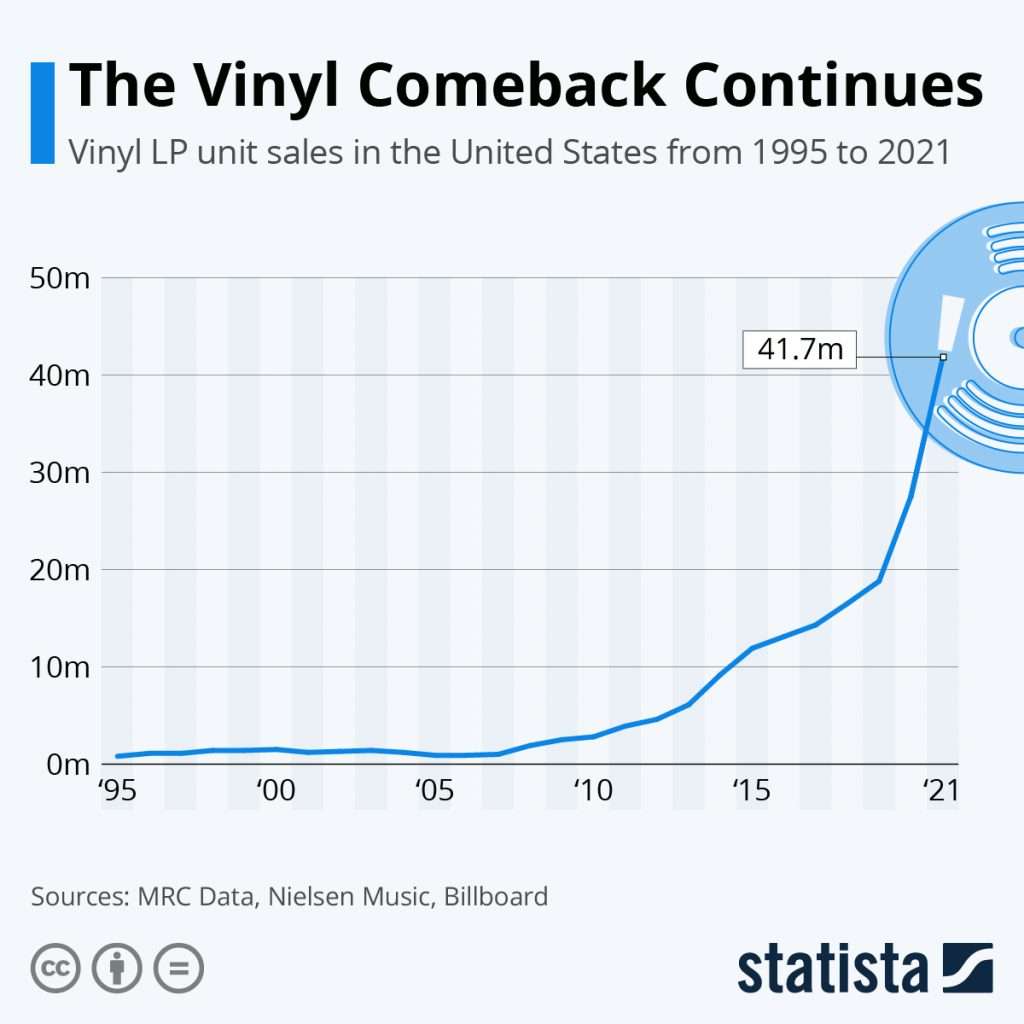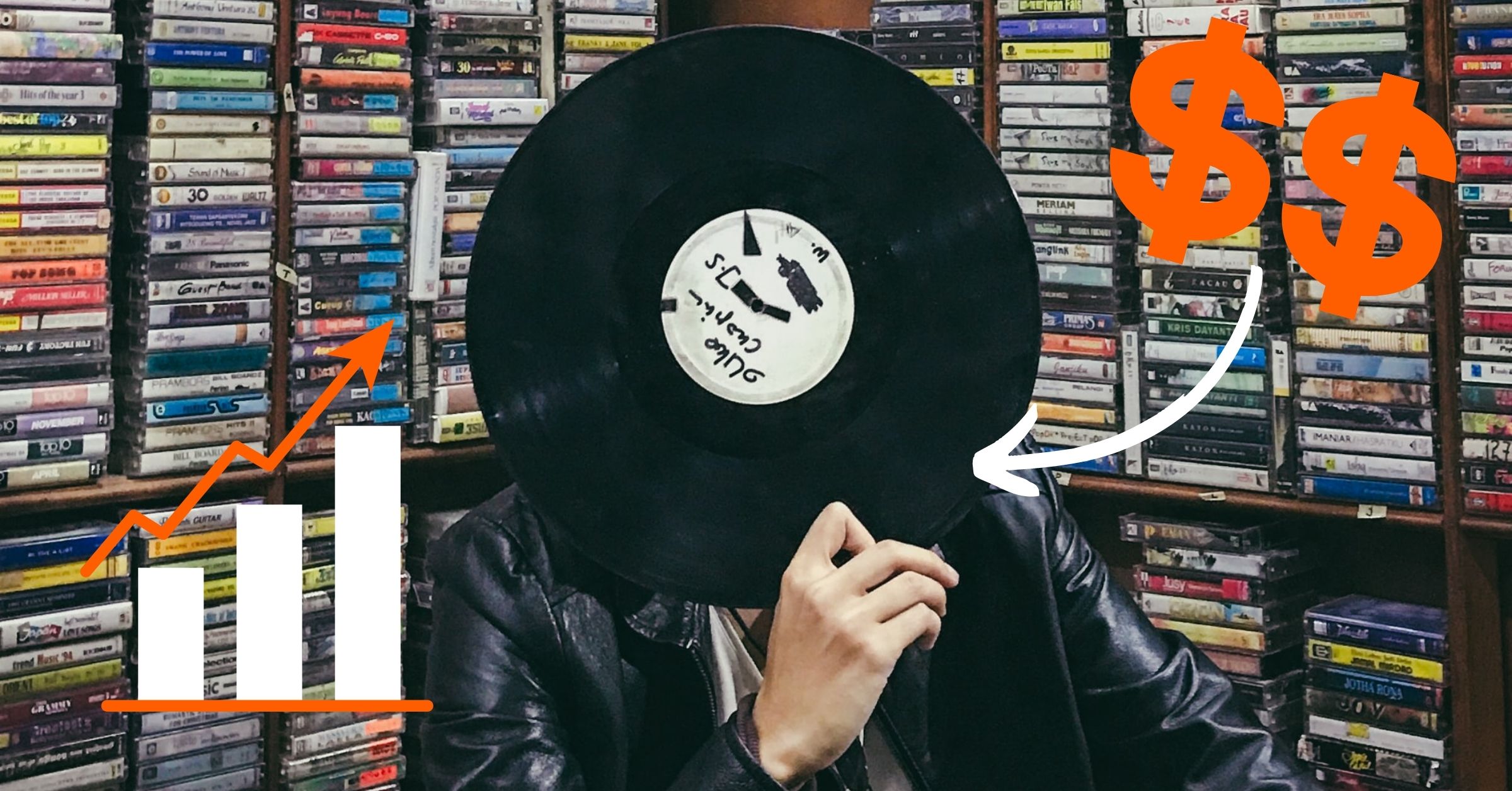It seems like everything is getting more expensive these days; vinyl records are no exception. It hasn’t always been this way, though. A decade ago, the new and used vinyl record market was very affordable. Let’s look at why vinyl is so expensive and what exactly is driving the price increases?
Why is a vinyl record so expensive?

Vinyl records are so expensive because interest in vinyl has been on the rise since 2007, but the production means have not met the demand, causing an imbalance in supply and demand. Between 2019 and 2021, vinyl sales skyrocketed by 121.34% to nearly 42 million vinyl albums sold (source)!
It’s been more expensive to buy records recently due to these factors:
- Demand, supply, and production costs
- Pressing cost
- Unique situations (ex: the COVID-19 pandemic)
Let us see how the supply, demand, and production costs affected vinyl LP prices.
The key theory or economic concept that exists here is that the more the demand for a product, the producers or manufacturers can charge high prices for the item. So similarly, if a product exists in the market for too long (the sale is low), that means the demand for that item is less in the market, which creates competition for the suppliers. Hence, the producers or manufacturers can sell the items at very cheap rates to keep the items moving in the market.
So, when the production (supply) and desire (demand) oppose each other, there is a lot of supply and less demand and a lot of demand, then market prices change. In this case, the latter happened, which caused the price of vinyl records to increase drastically.
What contributes to the increasing prices of vinyl?
We know that the cost of vinyl records has increased in the past few years due to more demand than supply, but what factors contribute to this happening?
Cost of labor
Labor costs around the world are increasing due to a variety of reasons. The vinyl industry relies on highly skilled technicians to calibrate and operate machinery to press records. If these technicians begin to disappear, the cost of labor goes up.
For example, during the COVID-19 pandemic, many people who oversaw the manufacturing process could not show up to work. This led to a worker shortage. Additionally, many older technicians who were close to retirement simply decided to retire early, so when production re-opened, fewer workers were available to run the machines.
Further, along with this point, the materials required to make vinyl records must also be collected and managed by workers. Industries that produced lacquer, nickel, and other raw materials also were experiencing a worker shortage.
Cost of materials
As mentioned above, the cost of materials has also been on the rise due to a limited supply of people available to manage the production of them and an increase in the demand for these materials.
On top of this, coloured vinyl records have now hit the mainstream, meaning more materials are required, hiking the prices even more.
If there are fewer materials available, the price will naturally rise.
Expertise
Not everyone can produce vinyl records, and it often takes many years of experience to fully master.
Furthermore, there are only 116 vinyl pressing plants globally (source), and even fewer are mass producing. Given the level of expertise required to make a vinyl record from start to finish and the few facilities that can produce them, the price of vinyl records had no option but to increase in response to the higher demand in recent years.
Time of production
Vinyl records are a large, physical form of media. This means they’re hard to produce in mass volumes. Each record takes roughly 30 seconds to press, which may not sound like a lot of time, but consider this:
- If it takes 30 seconds to produce a single record, two records can be made in a minute or 120 in an hour.
- Given 2021’s sales volume of nearly 42 million units, it would take 350,000 hours of production time to produce that quantity… That’s almost 40 years of time!
Other factors
Above, we’ve mentioned the main drivers that make vinyl records more expensive. However, that does not take into account:
- Payouts to artists and record labels
- Packaging and artwork costs
- Shipping costs
- Collectability and rarity
What’s the average cost of a vinyl record?
According to eBay shopping data, the average cost of a vinyl record was $4.80 in 2007. In 2017, the average price was $28.70 – and this is BEFORE issues with labor shortage and the COVID-19 pandemic through a wrench in things.
For some additional observational evidence, Beatles albums like Abbey Road, a fairly standard album many people own, currently costs $34.30 on Amazon as of writing this article in May 2023.
What does the role of the internet play in the cost of vinyl records?
The internet has made a lot of things more convenient for the average person, but sometimes it can lead to increasing costs – especially with vinyl records. Why is this?
The internet allows people to be introduced to the world of vinyl. Online communities such as the vinyl sub-Reddit have nearly 1-million users. This exposed people to vinyl as a hobby and contributed to the vinyl revival. With more people comes more demand.
Additionally, websites like Discogs allow collectors to see what prices people pay for records. Before Discogs, you could get a rare pressing of a record for a couple of dollars from a seller who didn’t know better. Now, people have a direct resource they can go to price their vinyl accordingly.
Major labels recognize the growing sales of vinyl records and begin to put new releases on vinyl. Now every music lover with a record player can experience their favorite artist on vinyl. Major labels also can create scarcity by limiting the production of a new release, further driving up the price at which it can be sold and re-sold for.
Finally, huge companies such as Amazon have entered the vinyl world to compete with record shops. Amazon makes buying online convenient and you can get your favorite album shipped directly to your door in 2 days or less. On top of that, you can even get your grocery shopping done in the same order!
Unfortunately, this has put a strain on your local record store. They can’t often match the prices of new vinyl releases and many have gone out of business. The record stores that are still around have to charge higher prices to keep in business. A small price to pay to keep your favorite local record shop in business though if you ask me.
Conclusion
Vinyl used to be a niche hobby, but now it’s growing at a rapid pace. More and more people are buying records and record players each year. This increase in demand has turned what was previously a small and dying industry into a resurging product in the music business.
Additionally, complications with labor, expertise, and raw materials have led to the production costs of vinyl increasing. Add on the boom in demand over the last decade, and you have a recipe for vinyl record prices skyrocketing through the roof.
We hope you found his article insightful. Thanks for reading!

Lead Editor / Owner
After beginning his career in the video and audio recording industry, Andrew started HiFi Hippo to share his knowledge and passion for vinyl and vintage audio with other readers.
